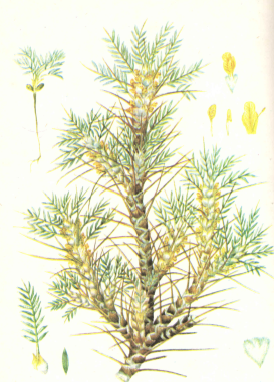A perennial plant with a taproot and a short stem; the entire plant is densely covered with white, woolly hairs. Leaves are 12–20 cm long, pinnately compound, on short petioles, with large triangular-lanceolate, needle-pointed, white, membranous stipules. Each leaf has 12–14 pairs of small, oblong-elliptical leaflets that are gray-green and densely covered with whitish hairs on both sides.
The flowers, 10–20 per dense capitate raceme, have peduncles shorter than the leaves. The flowers are yellow with a bell-shaped calyx that has five needle-like teeth and is woolly. The entire corolla is hairy, including the keel (a distinguishing feature from similar species). There are 9 fused stamens and one free stamen. The pod is hard, leathery, oval with a beak, grooved on the back, woolly, indehiscent, and not fully two-chambered. The seeds are flat, triangular, and yellow-green.
This is a steppe plant found in southern Ukraine, Moldova, and the North Caucasus region. The flowering herb, Herba Astragali dasyanthi, is harvested. The raw material has a slightly sweet taste in the flowers and stems, while the leaves are distinctly sweet.
The herb contains glycyrrhizin, the flavonoids quercetin and kaempferol, and trace elements. A water infusion is used for hypertension with symptoms of angina pectoris, as well as for acute and chronic nephritis. The infusion (10 g in 100 ml of water) is brewed like tea and taken 1–2 tablespoons 3–4 times a day.

The closely related species Astragalus glycyphyllus L. (sweet-leaved milk vetch), found in the European part of the region, has also been studied. It contains glycyrrhizin and exhibits hypotensive and diuretic effects.
The herbaceous plants of the large Astragalus genus remain poorly studied, suggesting potential for discovering promising species. Research has mainly focused on the shrub subgroup Tragacantha, which produces gum. This subgroup includes species like the densely branched Astragalus.
